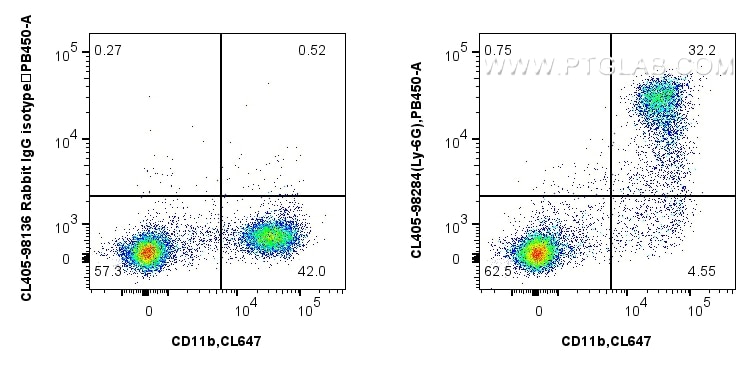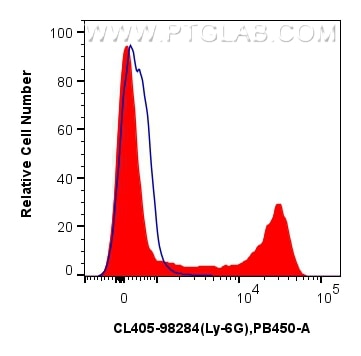Tested Applications
| Positive FC detected in | mouse bone marrow cells |
Recommended dilution
| Application | Dilution |
|---|---|
| Flow Cytometry (FC) | FC : 0.25 ug per 10^6 cells in a 100 µl suspension |
| This reagent has been tested for flow cytometric analysis. It is recommended that this reagent should be titrated in each testing system to obtain optimal results. | |
| Sample-dependent, Check data in validation data gallery. | |
Product Information
CL405-98284 targets Ly-6G in FC applications and shows reactivity with mouse samples.
| Tested Reactivity | mouse |
| Host / Isotype | Rabbit / IgG |
| Class | Recombinant |
| Type | Antibody |
| Immunogen |
CatNo: Eg2609 Product name: Recombinant Mouse Ly6g protein (rFc Tag) Source: mammalian cells-derived, V37 Tag: C-rFc Domain: 21-114 aa of NM_001310438.1 Sequence: AERAQGLECYNCIGVPPETSCNTTTCPFSDGFCVALEIEVIVDSHRSKVKSNLCLPICPTTLDNTEITGNAVNVKTYCCKEDLCNAAVPTGGSS Predict reactive species |
| Full Name | lymphocyte antigen 6 complex, locus G |
| Calculated Molecular Weight | 14 kDa |
| GenBank Accession Number | NM_001310438.1 |
| Gene Symbol | Ly-6G |
| Gene ID (NCBI) | 546644 |
| Conjugate | CoraLite® Plus 405 Fluorescent Dye |
| Excitation/Emission Maxima Wavelengths | 399 nm / 422 nm |
| Form | Liquid |
| Purification Method | Protein A purification |
| UNIPROT ID | P35461 |
| Storage Buffer | PBS with 0.09% sodium azide, pH 7.3. |
| Storage Conditions | Store at 2-8°C. Avoid exposure to light. Stable for one year after shipment. |
Background Information
Ly-6G (lymphocyte antigen 6 complex, locus G), also known as Gr-1, is a 21-25 kDa, glycosylphosphatidylinositol-anchored protein expressed on myeloid lineage cells in mouse bone marrow (PMID: 8360469). The expression of Ly-6G increases on neutrophils as they differentiate from immature cells in the bone marrow to mature cells in the blood and spleen (PMID: 8890901).
Protocols
| Product Specific Protocols | |
|---|---|
| FC protocol for CL Plus 405 Ly-6G antibody CL405-98284 | Download protocol |
| Standard Protocols | |
|---|---|
| Click here to view our Standard Protocols |






